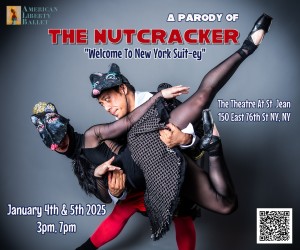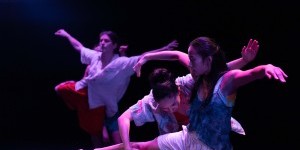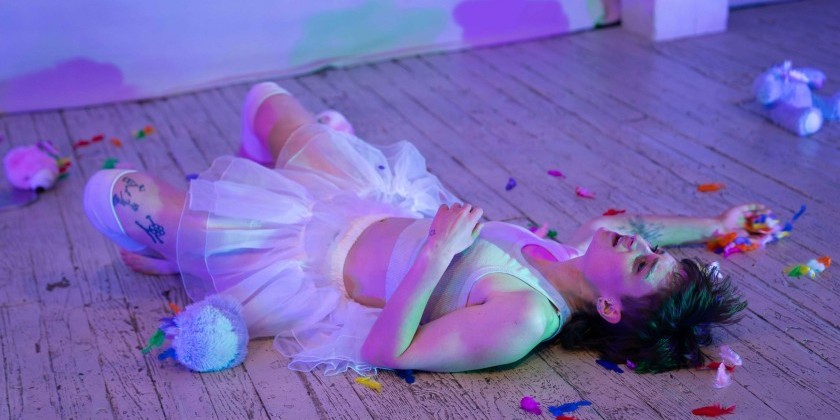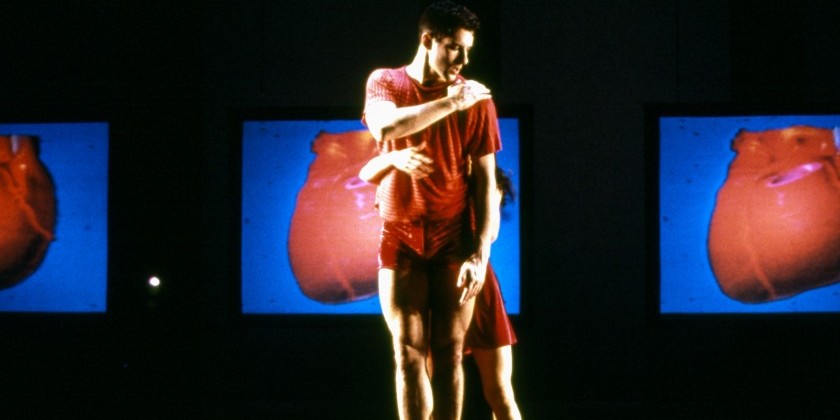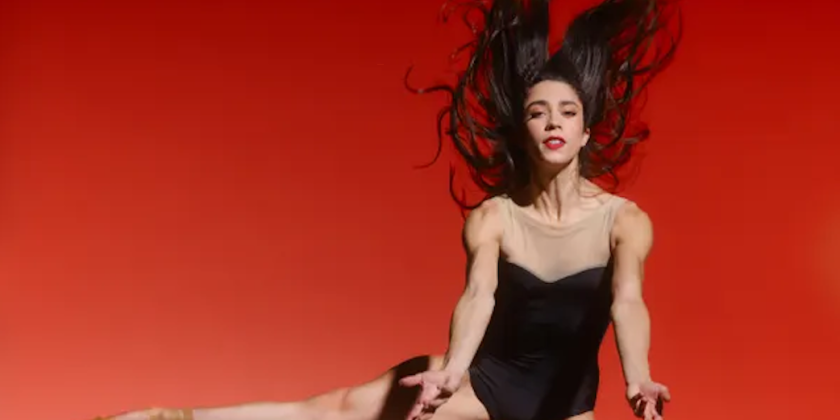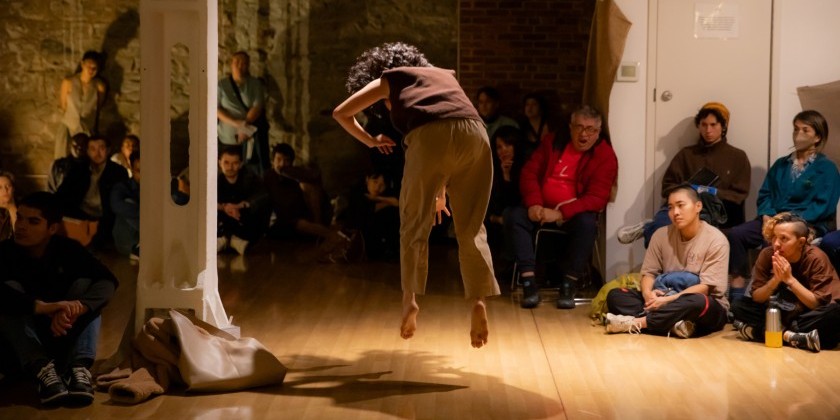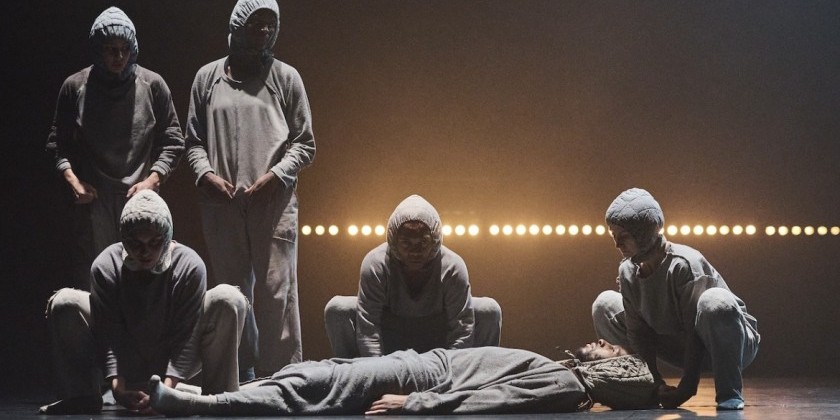AUDIENCE REVIEW: "Lines in the Sand, TBD" by The Lovelies

Company:
The Lovelies
Performance Date:
Saturday, January 26, 2018
Freeform Review:
There is a dangerous quality to the mysteries of improvisation and to the semblance of real life on stage. When there is something expected and something to be attained, the demand can seem overwhelming, yielding either a fierce focus on the task at hand or utter failure; and of all the incendiary possibilities of making dance, it seems the elemental facets brought by each performer can rely heavily on every other element onstage. In their process of compositional improvisation, The Lovelies pursue a constant examination of the elemental, and the exploration of the individual to the whole. Lucky for us they approach their work fervently, but with a refreshing sense of wonder as well.
Benjamin Louis Brody sat down unassumingly amidst an amplifier, pedals, and his guitar. Kirin McElwain, with her acoustic bow and cello in hand, was a huntress at the ready. As they prepared themselves in the silence, an interesting dynamic was already at play – electric versus acoustic – then darkness. The lights would rise on five more performers, and a growing pulse emerged from Mr. Brody with whammy-wavelengths spinning forward and retreating like an old locomotive gathering strength. Ms. McElwain responded in kind, creating resonant ripples like ocean waves at high tide with her swift bow work in a register all her own. The Lovelies began in a formation reminiscent of five spots on a die, breathing and listening, almost buzzing with anticipation. Then, with a weight shift, a change in focus, and fingers articulating in side light, they were off.
There is an engaging quality about The Lovelies stemming from their attunement to each other that seems akin to classical chamber groups. However, this group is armed with previous shared experiences to empower them and the present moment to evoke them as they traverse the unknown together with passion, playfulness, and panache. Never nonchalant but also never overwrought, whether in duet or trio against two or tout ensemble, there is a feeling of responsibility here as well as freedom.
Straddling the line between performers and creators, The Lovelies are in continuous movement whether seen or unseen. They are moved to allow or add, to provide or pounce upon, to stand back or stand down, interject or instigate, but it is always with a fierce understanding of the needs of the piece that they are moved. After all, they know there is an audience, and this is a performance. What seems essential for any form of improvisation isn’t enough for The Lovelies, who seem to demand so much from this form and each other in order to build an engaging, even enlightening premise and philosophy. The Lovelies have a knack for not allowing the molten iron of creation to cool too quickly. These dance-smiths allow motifs to come to life, develop, and flow through their bones and imaginations to the fruition they see fit. From instances of fiery contact like communion and constricting space and time, to the cooling fluidity of solo or duet work, it is with a physical prowess that demands attention. It’s an interesting challenge as an audience member, especially in an intimate setting like Triskelion, to try and spot the cerebral choice being made, but the pace at which moods and movement can shift in tone can be part of the beauty of this ephemeral work, leaving us much more interested in what’s to come than what just was. Moments spring up and disappear, moments can sustain our attention too, because it always seems that they are created with an inspired ease, a driven precision, and an engrossing energy.
Choosing to have spoken word through acoustic and electronic means seems like a comment on the musicians’ instrumental nature, and it is through this relationship of acoustic and electronic voices that we can decipher snarky undertones, “sticky situations,” or even wild wisdom. In a similar fashion, the musicians lent themselves to something altogether new and progressive and at times even familiar – in fragmented reminiscences of the blues, or early jazz progressions. The spoken word peppered throughout “Lines in the Sand, TBD” proved revelatory at times, hilarious at others, inspiring too; as if we were catching secret sound bites of rehearsal chatter or self awareness within their process of creation. Curiosity and a sense of play made for compelling and illuminating work, surprising audience and performers alike. Catching moments of individuality within the group also made for some standout moments, but it’s in the eyes of these improvisers that one could see flashes of light or sadness throughout the evening, glimpses of something underneath their speaking sinews.
Towards the end of the piece as they stood on the far right of the stage casting a diagonal line in a tight formation, The Lovelies began to prepare themselves and their audience for the ending, the pièce de résistance. We hear a jumble of plans for something spectacular (though perhaps unrealistic, admitted by a single dancer with self-effacing humor), and as one voice rings out above the din, “Last chance – dance,” we all begin to buzz with anticipation. The audience seems bombarded with distinct voices interrupting each other in a rising sense of pressure and expectation. Suddenly privy to the nerves that may precede a great feat, we become aware of their humanity, fallible, fractured – but willing. Nothing maudlin here though, as through much of the piece, there’s a shared rhythm between them that provides for an effervescent cascade of conflict and earnest longing. This time though The Lovelies are silhouetted in nervous energy – here they are ready to go off the high dive for us as their words come full circle, perhaps ending the piece where any improviser might begin – where we all may find ourselves in the face of challenging beginnings – stuck inside our minds, almost paralyzed by the pressure of possibility.
Plunged into sudden darkness, the audience is left imagining, perhaps still yearning to see the impossible, but also perhaps inspired to dance as well. For if you had one last chance to dance, what would you do?
By Michael Vitaly Sazonov
Author:
Michael Vitaly Sazonov
Website:
michaelvitaly.com
Photo Credit:
By Andy Ribner





